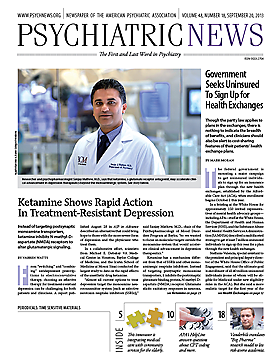The federal government is mounting a major campaign to get uninsured individuals to sign up for an insurance plan through the new health exchanges, established by the Affordable Care Act (ACA), when enrollment begins October 1 this year.
In a briefing at the White House for approximately 150 invited representatives of mental health advocacy groups—including APA—staff at the White House, the Department of Health and Human Services (HHS), and the Substance Abuse and Mental Health Services Administration (SAMHSA) described a multifaceted strategy to get at least 7 million uninsured individuals to sign up this year for a plan through the new health exchanges.
Steffanie Valencia, special assistant to the president and principal deputy director of the White House Office of Public Engagement, said that the ultimate goal is enrollment of all 40 million uninsured individuals (some of whom will be eligible for Medicaid under new eligibility rules in the ACA). But she said a more realistic target for the first year of the new exchanges, as established by the Congressional Budget Office, is 7 million.
Enrollment begins October 1, 2013, and ends March 31, 2014, leaving a window of approximately 180 days for the government to accomplish its task.
Valencia described a strategy whereby she expected young people to be surrounded by messages—from physicians, religious leaders, teachers, family members, and community leaders—explaining the benefits of health insurance. “We want people to be hearing about this everywhere they turn,” she said.
She was joined during the briefing by Howard Koh, M.D., the HHS assistant secretary for health; Christen Linke-Young, director of coverage policy in the HHS Office of Health Reform; and Pamela Hyde, administrator of SAMHSA, which is part of HHS.
The briefing was a follow-up to the National Conference on Mental Health, hosted by President Obama at the White House in June, to talk about raising awareness of mental health issues. At last month’s briefing, Valencia and other administration officials said they were counting on advocacy and provider groups to help in enlisting enrollment in the new exchanges.
They drew attention to a website,
http://marketplace.cms.gov, which is designed for mental health professionals wishing to help patients get enrolled.
The opening of the exchanges, along with the expansion of Medicaid, will extend mental health benefits to millions of Americans. States were given the choice to build a fully state-based exchange, enter into a state-federal partnership exchange, or default into a federally facilitated exchange; the ACA directs the secretary of HHS to establish and operate a federally facilitated exchange in any state that is not able or willing to establish a state-based exchange (see website at end of article for state information).
But Irvin “Sam” Muszynski, director of APA’s Office of Healthcare Systems and Financing, told Psychiatric News that there are a number of unknowns regarding what the plans in the health exchanges will look like.
Because of the requirement that all plans offer a mental health benefit, the plans will have to comply with the terms of the 2008 Mental Health Parity and Addiction Equity Act. States have been assigned the task of designing the essential health benefits (EHBs) that will be offered by the plans in their exchanges, with the stipulation that these benefits may not fall below those provided by a benchmark plan chosen in the state. HHS has said the EHB benchmark plan that a state may use must be one of the following:
The largest plan by enrollment in any of the three largest small-group insurance plans in the state’s small-group market.
Any of the three largest state employee health benefit plans by enrollment.
Any of the three largest plans by enrollment in the Federal Employees Health Benefits Program (FEHBP).
The largest insured commercial non-Medicaid HMO operating in the state.
The state’s benchmark plan comprises the state’s EHBs, plus whatever state benefit mandates that state had on its books by December 2011. The plan types must include 10 health service categories, and if the plan type selected by a state—say, a small-group employer plan—lacks one of these categories, it has to take a category from another HHS-approved plan type, perhaps a Medicaid HMO plan or a plan from the FEHBP, and supplement its benchmark plan type.
Muszynski cautioned that nothing in the ACA indicates the breadth of services that will be covered within a particular required essential health benefit category—that is, plans could offer a benefit for, say, substance abuse treatment, but pay only for a narrow range of treatment services.
Moreover, clinicians treating patients enrolled in the exchanges need to be alert to cost-sharing features of the plans. The exchanges offer plans in four levels of premiums, with varying deductibles at each level; the lowest-level plan covering a family of four may have a deductible as high as $5,000.
Finally—and crucially—Muszynski stressed that clinicians need to review contracts they have signed with health plans to determine if those plans will be part of the exchanges, and if so, whether existing contractual arrangements will continue or need to be renewed.
Some states have outlawed so-called “all-products clauses”—contractual clauses that require a physician in a provider network for one company to be in the network for all of the insurance company’s products. Other states allow all-products clauses for provider contracts, so clinicians are advised to inquire about all-products clauses that may affect their status as providers within a health exchange plan.
“Clinicians need to know where they stand under current payer contracts and whether they are considered part of these exchanges,” he said. ■

